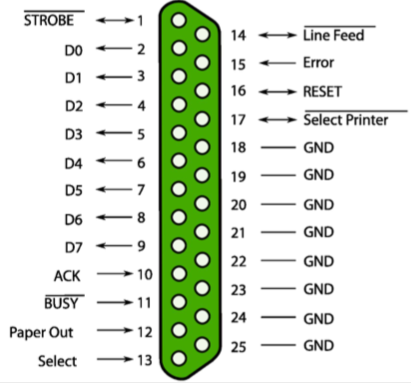Operating Systems
Table of Contents
Principles of IO hardware
IO devices available to software via an interface
- character devices: all IO occurs as stream of bytes
- block devices: all IO occurs in units of randomly accessible blocks
device controller
- located between actual device and computer
- offers electronic interface via IO registers
- R/W those registers to ask controller to perform actions
example: parallel port

accessing IO registers
- port-mapped IO (PMIO):
- IO registers are accessed via dedicated port numbers and special instructions
- e.g. inb instruction
- memory-mapped IO (MMIO):
- IO registers are mapped into address of main memory
- can be accessed with a simple mov
- intel x86 is hybrid, does both PMIO and MMIO
IO ports have a specification from the manufacturer (e.g. IBM PC)
waiting for requests:
- we can send commands to devices, but what if requested operation takes time?
- polling:
- most devices offer status bits in registers to signal that request has been finished (incl. error code)
- OS can poll this status bit (“polling”)
- is this a good solution? not a general purpose solution, but good if we know it’ll complete in a short amount of time.
- interrupts:
- device controller can trigger interrupts to signal that IO requesst is complete
- for device, means changing voltage on an electrical line
- each controller has interrupt vector assigned
- CPU runs vector-specific handler when interrupt occurs
- process one interrupt at a time
- device controller can trigger interrupts to signal that IO requesst is complete
data exchange between device and CPU
- how do we transfer data from hard disk to memory?
- program disk controller to read sector
- wait for interrupt
- read a device register sizeof(sector) consecutive times
- repeat for next sector
- problem? yes sir. CPU cycles can be spent in a better way
- so just let hardware do the copying – Direct Memory Access!
- on ISA systems, there was a dedicated DMA controller (third-party)
- on PCI (and PCIe) systems each PCI device can become “Bus Master” and perform DMA (first-party DMA)
- device and DMA controller are combined
- you have to trust your hardware (or use an IO MMU)
- embedded systems still have dedicated DMA controller
- disk controller still uses own buffers